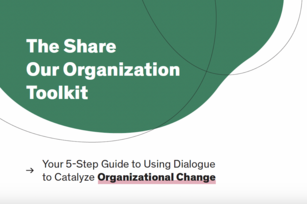Abortion is one of the most polarized topics in American politics—one side favors access, the other side favors restriction. Simple enough, right?
Not at all. Polling shows that Americans hold nuanced, complex, sometimes contradictory perspectives on abortion. Ironically, it is the complexity of those views that creates the circumstances for polarization. People have so few opportunities to talk about abortion deeply, openly. It is often taboo. Just as often, it is too difficult to articulate their views—and people choose silence instead. This absence allows extreme voices to dominate in the media, in our politics, and in our communities.
On abortion, few, if any, political leaders express the views of the people they represent. But we can change that—together.
The Supreme Court has handed down a decision that effectively reversed Roe vs. Wade. This turns one polarized national conversation into fifty distinct deliberations unique to the history, context, and communities within each state. We need to empower the voices of everyday people, so they can articulate and advocate for their genuine, nuanced views.
This guide is designed to invite you to have a new dialogue about abortion. To transform the conversation in your context, it is crucial that you allow space for whatever comes up for people, even (or especially) if it is messy. It includes structures, tips, and prompts for conversations:
- Across differences of perspective on the issue of abortion access
- For spaces where talking about abortion feels taboo
- To grieve this change and find strength in your community
- Where you can talk about how to support families well in your community
- For religious and inter-religious groups to talk about abortion
Co-founder Laura Chasin, who co-led confidential leadership dialogues about abortion (under the banner of the Public Conversations Project) for the better part of a decade, often spoke of “liberation through structure.” It is so easy for conversations on this topic to go off the rails and devolve into unproductive venting or harmful, polarizing rhetoric—especially in times like these.
Structures and norms like the ones we suggest in our new guide may feel awkward, but they also create the possibility of a new kind of conversation. You have to step out of your normal way of speaking and relating to one another in order to free yourself of dysfunctional, polarizing patterns.
This guide is designed to help you give any group an opportunity to reflect on the impact of the draft Supreme Court decision in a way that builds empathy, understanding, trust, and compassion—then, if you choose, to help people wrestle with how they want to come together as a community to support people in a variety of ways.
Within this resource you will find general tips as well as guidelines and prompts for more formal dialogues that you can hold in your classroom, bible study, book club, institution, or community space.
If this guide doesn't meet the needs of your context, if you have questions about the use of this guide, or if you want some additional support and collaboration, please reach out for a free consultation with an EP expert.
























